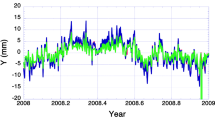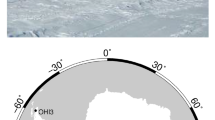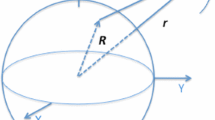Abstract
We distinguish between geocenter location and geocenter motion for their different purposes: precise orbit determination (POD) and earth surface mass variation monitoring. We present a method to measure the geocenter location through GPS tracked low earth orbiters (LEO) POD. We propose two methods to apply these geocenter location estimates to earth surface mass variation study. 19 years of daily geocenter locations in IGS14 reference frame are estimated from the POD of GPS tracked LEOs. These estimates are applied to 296 globally distributed GPS ground stations measured in the same reference frame for surface mass variation inversion. The results show that such determined geocenter location reaches sub-millimeter precision in each component judged by RMS of the overlap** differences. The geocenter motion change measured using the 80-station GPS orbit and clock product shows similar annual variation to the degree-1 term of the surface mass variation spherical harmonics determined from the 296-station inversion.







Similar content being viewed by others
Data availability
LEO GPS tracking data used for this study are from GRACE and GRACE-FO missions https://podaac.jpl.nasa.gov/dataset, SWARM mission http://earth.esa.int/eogateway/missions/swarm/data, Sentinel-3 missions https://scihub.copernicus.eu/gnss/#/home, Jason-2 and -3 missions https://www.avl.class.noaa.gov/saa/products. The JPL GPS orbit and clock product are from https://sideshow.jpl.nasa.gov/pub/JPL_GPS_Products. The 60-day SLR solutions are from The University of Texas at Austin Center for Space Research (https://filedrop.csr.utexas.edu/pub/slr/geocenter/60_day_geocenter_constrained_heights_detrended.txt). The “OBP + GRACE” geocenter motion solution is from JPL’s GRACE Technical Note #13c (https://podaac.jpl.nasa.gov/gravity/grace-documentation#TechnicalNotes). The “Inverse” solution of Wu et al. 2020 is provided by the author and available upon request. The three time series of daily geocenter location from GRACE solution, GRACE-FO solution and the 7-LEO solution are available upon request. The 19-year combined monthly geocenter location time series, as well as the inversion solution of the degree-1 geocenter motion are also available upon request.
References
Abbondanza C, Chin TM, Gross RS, Heflin MB, Parker J, Soja BS, van Dam T, Wu X (2017) JTRF2014, the JPL Kalman filter, and smoother realization of the international terrestrial reference system. J Geophys Res Solid Earth 122:8474–8510. https://doi.org/10.1002/2017JB014360
Altamimi Z, Collilieux X, Legrand J, Garayt B, Boucher C (2007) ITRF2005 a new release of the international terrestrial reference frame based on time series of station positions and earth orientation parameters. J Geophys Res. https://doi.org/10.1029/2007JB004949
Altamimi Z, Collilieux X, Metivier L (2011) ITRF2008: an improved solution of the international terrestrial reference frame. J Geod 85(8):457–473. https://doi.org/10.1007/s00190-011-0444-4
Altamimi Z, Rebischung P, Métivier L, Collilieux L (2016) ITRF2014: a new release of the international terrestrial reference frame modeling nonlinear station motions. J Geophys Res Solid Earth 121:6109–6131. https://doi.org/10.1002/2016JB013098
Altamimi Z, Rebischung P, Collilieux X, Metivier L, Chanard K (2023) ITRF2020: an augmented reference frame refining the modeling of nonlinear station motions. J Geod 97:47. https://doi.org/10.1007/s00190-023-01738-w
Bertiger W, Desai SD, Haines B, Harvey N, Moore AW, Owen S, Weiss JP (2010a) Single receiver phase ambiguity resolution with GPS data. J Geod 84:327–337. https://doi.org/10.1007/s00190-010-0371-9
Bertiger W, Desai SD, Dorsey A, Haines BJ, Harvey N, Kuang D, Sibthorpe A, Weiss JP (2010b) Sub-centimeter precision orbit determination with gps for ocean altimetry. Mar Geodesy 33(S1):363–378. https://doi.org/10.1080/01490419.2010.487800
Cheng MK (1999) Geocenter variations from analysis of TOPEX/POSEIDON SLR data. IERS analysis campaign to investigate motions of the geocenter, IERS technical note, vol 25. Observatoire De Paris, Paris, pp 39–44
Cheng MK, Ries JC, Tapley BD (2013) Geocenter variations from analysis of SLR data, in reference frames for applications in geosciences. International association of geodesy symposia, vol 138. Springer, Berlin, pp 19–26
Desai SD, Haines BJ, Kuang D (2019) Long wavelength time variable gravity recovered from GPS-based precise orbit determination of multiple low-earth orbiters, In: 2019 GRACE science team meeting, Pasadena, USA
Dong D, Yunck T, Heflin M (2003) Origin of the international terrestrial reference frame. J Geophys Res 108(B4):2200–2209
Haines B, Bar-Sever Y, Bertiger W, Desai S, Willis P (2004) One-centimeter orbit determination for Jason-1: new GPS-based strategies. Mar Geodesy 27(1–2):299–318
Haines BJ, Bar-Sever YE, Bertiger WI, Desai SD, Harvey N, Sibois AE, Weiss JP (2015) Realizing a terrestrial reference frame using the global positioning system. J Geophys Res Solid Earth. https://doi.org/10.1002/2015JB012225
Heflin M, Bertiger W, Blewitt G, Freedman A, Hust K, Lichten S, Lindqwister U, Vigue Y, Webb F, Yunck T, Zumberge J (1992) Global geodesy using GPS without fiducial sites. Geophys Res Lett 19(2):131–134
Jäggi A, Dahle C, Arnold D, Bock H, Meyer U, Beutler G, van den Ijssel J (2016) Swarm kinematic orbits and gravity fields from 18 months of GPS data. Adv Space Res 57(1):218–233
Kang Z, Tapley B, Chen J, Ries J, Bettadpur S (2009) Geocenter variations derived from GPS tracking of the GRACE satellites. J Geod 83:895–901
Kuang D, Schutz BE, Watkins MM (1996) On the structure of geometric positioning information in GPS measurements. J Geod 71:35–43
Kuang D, Bar-Sever Y, Haines B (2015) Analysis of orbital configurations for geocenter determination with GPS and low-earth orbiters. J Geod 89(5):471–481. https://doi.org/10.1007/s00190-015-0792-6
Kuang D, Bertiger WI, Desai SD, Haines BJ, Yuan DH (2019) Observed geocenter motion from precise orbit determination of GRACE satellites using GPS tracking and accelerometer data. J Geod 93(10):1835–1844. https://doi.org/10.1007/s00190-019-01283-5
Landerer FW, Flechtner FM, Save H, Webb FH, Bandikova T, Bertiger WI, Bettadpur SV, Byun SH, Dahle C, Dobslaw H, Fahnestock E, Harvey N, Kang Z, Kruizinga G, Loomis BD, McCullough C, Murböck M, Nagel P, Paik M, Pie N, Poole S, Strekalov D, Tamisiea ME, Wang F, Watkins MM, Wen HY, Wiese DN, Yuan DN (2020) Extending the global mass change data record: GRACE Follow-On instrument and science data performance. Geophys Res Lett 47:e2020GL088306. https://doi.org/10.1029/2020GL088306
Lavallee D, van Dam T, Blewitt G, Clarke P (2006) Geocenter motions from GPS: a unified observation model. J Geophys Res 111:B05405
Malys S, Jensen PA (1990) Geodetic point positioning with GPS carrier beat phase data from the CASA UNO experiment. Geophyd Res Lett 17(5):651–654
Montenbruck O, Hackel S, Jäggi A (2018) Precise orbit determination of the Sentinel-3A altimetry satellite using ambiguity-fixed GPS carrier phase observations. J Geodesy 92:711–726. https://doi.org/10.1007/s00190-017-1090-2
Pavlis EC (1999) Fortnightly resolution geocenter series: a combined analysis of LAGEOS 1 and 2 SLR data (1993–1996). IERS analysis campaign to investigate motions of the geocenter, IERS technical note, vol 25. Observatoire De Paris, Paris, pp 75–84
Rebischung P, Altamimi Z, Springer T (2014) A colinearity diagnosis of the GNSS geocenter determination. J Geod 88(1):65–85. https://doi.org/10.1007/s00190-013-0669-5
Sun Y, Riva R, Ditmar P (2016) Optimizing estimates of annual variations and trends in geocenter motion and J2 from a combination of GRACE data and geophysical models. J Geophys Res Solid Earth 121:8352–8370. https://doi.org/10.1002/2016JB013073
Swenson S, Chambers D, Wahr J (2008) Estimating geocenter variations from a combination of GRACE and ocean model output. J Geophys Res 113:B08410. https://doi.org/10.1029/2007JB005338
Tapley B, Bettadpur S, Watkins M, Reigber C (2004) The gravity recovery and climate experiment: mission overview and early results. Geophys Res Lett 31(9):L09607. https://doi.org/10.1029/2004GL019920
Vigue Y, Lichten SM, Blewitt G, Heflin MB, Malla RP (1992) Precise determination of earths center of mass using measurements from the global positioning system. Geophys Res Lett 19(14):1487–1490
Wahr J, Molenaar M (1998) Time variability of the earth’s gravity field: hydrological and oceanic effects and their possible detection using GRACE. J Geophys Res 103(B12):30205–30229
Watkins MM, Eanes RJ (1997) Observations of tidally coherent diurnal and semidiurnal variations in the geocenter. Geophys Res Lett 24(17):2231–2234
Wu SC, Yunck TP, Thornton CL (1991) “Reduced-dynamic technique for precise orbit determination of low earth satellites. J Guid Control Dyn 14(1):24–30
Wu X, Argus DF, Heflin MB, Ivins ER, Webb FH (2002) Site distribution and aliasing effects in the inversion for load coefficients and geocenter motion from GPS data. Geophys Res Lett 29(24):2210. https://doi.org/10.1029/2002GL016324
Wu X, Ray J, van Dam T (2012) Geocenter motion and its geodetic and geophysical implications. J Geodyn 58:44–61. https://doi.org/10.1016/j.jog.2012.01.00
Wu X, Abbondanza C, Altamimi Z, Chin TM, Collilieux X, Gross RS, Heflin MB, Jiang Y, Parker JW (2015) KALREF—a Kalman filter and time series approach to the international terrestrial reference frame realization. J Geophys Res Solid Earth 120:3775–3802. https://doi.org/10.1002/2014JB011622
Wu X, Kusche J, Landerer FW (2017) A new unified approach to determine geocenter motion using space geodetic and GRACE gravity data. Geophys J Int 209:1398–1402. https://doi.org/10.1093/gji/ggx086
Wu X, Haines BJ, Heflin MB, Landerer FW (2020) Improved global nonlinear surface mass variation estimates from geodetic displacements and reconciliation with GRACE data. J Geophys Res Solid Earth 125:e201JB9018355. https://doi.org/10.1029/2019JB018355
Zielinski JB (1989) GPS baseline error caused by the orbit uncertainty. Manuscri Geod 14:117–124
Zumberge JF, Heflin MB, Jefferson DC, Watkins MM, Webb FH (1997) Precise point positioning for the efficient and robust analysis of GPS data from large networks. J Geophys Res Solid Earth 102(5005–5017):96JB03860
Acknowledgements
The work described in this paper is carried out at the Jet Propulsion Laboratory, California Institute of Technology, under contract with the National Aeronautics and Space Administration (NASA). LEO GPS tracking data are from missions by European Space Agency (ESA), U.S. National Oceanic and Atmospheric Administration (NOAA), and NASA. The constructive suggestions from two anonymous reviewers are greatly appreciated.
Funding
Funding was provided by National Aeronautics and Space Administration.
Author information
Authors and Affiliations
Contributions
DK formulated the algorithm and processed the data; SD selected the LEO configurations and prepared the data; BH verified the POD strategy and solutions; XW developed and carried out the application. All authors discussed the results together and reviewed the manuscript.
Corresponding author
Ethics declarations
Conflict of interest
The authors declare no competing interests.
Additional information
Publisher's Note
Springer Nature remains neutral with regard to jurisdictional claims in published maps and institutional affiliations.
Rights and permissions
Springer Nature or its licensor (e.g. a society or other partner) holds exclusive rights to this article under a publishing agreement with the author(s) or other rightsholder(s); author self-archiving of the accepted manuscript version of this article is solely governed by the terms of such publishing agreement and applicable law.
About this article
Cite this article
Kuang, D., Desai, S.D., Haines, B.J. et al. Point positioning the geocenter through LEO GPS tracking and its application in geophysics. GPS Solut 28, 137 (2024). https://doi.org/10.1007/s10291-024-01680-0
Received:
Accepted:
Published:
DOI: https://doi.org/10.1007/s10291-024-01680-0




